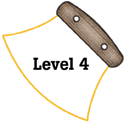|
National Science Education Standards
The nuclear forces that hold the nucleus of an atom together, at nuclear
distances, are usually stronger than the electric forces that would make
it fly apart. Nuclear reactions convert a fraction of the mass of interacting
particles into energy, and they can release much greater amounts of energy
than atomic interactions. Fission is the splitting of a large nucleus
into smaller pieces. Fusion is the joining of two nuclei at extremely
high temperature and pressure, and is the process responsible for the
energy of the sun and other stars. (Page 178)
Radioactive isotopes are unstable and undergo spontaneous nuclear reactions,
emitting particles and/or wavelike radiation. The decay of any one nucleus
cannot be predicted, but a large group of identical nuclei decay at a
predictable rate. This predictability can be used to estimate the age
of materials that contain radioactive isotopes. (Page 178)
Atoms interact with one another by transferring or sharing electrons
that are furthest from the nucleus. These outer electrons govern the chemical
properties of the element. (Page 178)
Bonds between atoms are created when electrons are paired up by being
transferred or shared. A substance composed of a single kind of atom is
called an element. The atoms may be bonded together into molecules or
crystalline solids. A compound is formed when two or more kinds of atoms
bind together chemically. (Page 179)
The physical properties of compounds reflect the nature of the interactions
among its molecules. These interactions are determined by the structure
of the molecule, including the constituent atoms and the distances and
angles between them. (Page 179)
Carbon atoms can bond to one another in chains, rings, and branching
networks to form a variety of structures, including synthetic polymers,
oils, and the large molecules essential to life. (Page 179)
Chemical reactions occur all around us, for example in health care,
cooking, cosmetics, and automobiles. Complex chemical reactions involving
carbon-based molecules take place constantly in every cell in our bodies.
(Page 179)
Chemical reactions may release or consume energy. Some reactions such
as the burning fossil fuels release large amounts of energy by losing
heat and by emitting light. Light can initiate many chemical reactions
such as photosynthesis and the evolution of urban smog. (Page 179)
A large number of important reactions involve the transfer of either
electrons (oxidation/reduction reactions) or hydrogen ions (acid/base
reactions) between reacting ions, molecules, or atoms. In other reactions,
chemical bonds are broken by heat or light to form very reactive radicals
with electrons ready to form new bonds. Radical reactions control many
processes such as the presence of ozone and greenhouse gases in the atmosphere,
burning and processing of fossil fuels, the formation of polymers, and
explosions. (Page 179)
Chemical reactions can take place in time periods ranging from the few
femtoseconds (10 –15 seconds) required for an atom to move a fraction
of a chemical bond distance to geologic time scales of billions of years.
Reaction rates depend on how often the reacting atoms and molecules encounter
one another, on the temperature, and on the properties—including
shape—of the reacting species. (Page 179)
Catalysts, such as metal surfaces, accelerate chemical reactions. Chemical
reactions in living systems are catalyzed by protein molecules called
enzymes. (Page 179)
|
|
Benchmarks
The nucleus of radioactive isotopes is unstable and spontaneously decays,
emitting particles and/or wavelike radiation. It cannot be predicted exactly
when, if ever, an unstable nucleus will decay, but a large group of identical
nuclei decay at a predictable rate. This predictability of decay rate
allows radioactivity to be used for estimating the age of materials that
contain radioactive substances. (Page 80)
Atoms often join with one another in various combinations in distinct
molecules or in repeating three-dimensional crystal patterns. An enormous
variety of biological, chemical, and physical phenomena can be explained
by changes in the arrangement and motion of atoms and molecules. (Page
80)
The configuration of atoms in a molecule determines the molecule’s
properties. Shapes are particularly important in how large molecules interact
with others. (Page 80)
The rate of reactions among atoms and molecules depends on how often
they encounter one another, which is affected by the concentration, pressure,
and temperature of the reacting materials. Some atoms and molecules are
highly effective in encouraging the interaction of others. (Page 80)
|


